Water and Sanitation
The level of water security and hygiene in a refugee camp depends on two factors: the facilities provided and the population’s hygienic behavior.
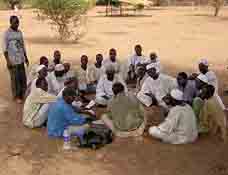
A sufficient hygienic situation can only be achieved by a strategy of distributing knowledge, mobilizing residents and providing residents with essential facilities and materials. Water is not only needed for nutrition but also plays a crucial role in the hygienic situation of the camp. Therefore, the sound provision of and the accessibility of water sources and sanitation facilities does not only effect personal comfort also the overall hygienic situation in the camp. Standards are defined and described in the Sphere Handbook.
Hygiene promotion
Assessment: Planning starts with the identification of risky behaviors, priorities and weak population groups.
Participation: Hygiene standards are developed both by the agency’s and the population’s knowledge, practices and resources. The needs of vulnerable groups should be especially considered. Therefore, facilities reflect the needs, vulnerabilities and preferences of the users.
 Promotion: 2 promoters/ 1000 people, regarding social customs (in some cultures women are not allowed to speak to men) / & conditions (illiteracy).
Promotion: 2 promoters/ 1000 people, regarding social customs (in some cultures women are not allowed to speak to men) / & conditions (illiteracy).
Involvement: Users participate in the planning, and therefore develop a sense of ownership and responsibility for the maintenance of the facilities.
Accessibility, facilities and equipment
Selection of source or delivery: Sustainable availability, constant or regular availability, water quality, proximity / social implications.
Equal accessibility: Distance between household and water-point: 150m max., safety also for endangered groups (women, minorities).
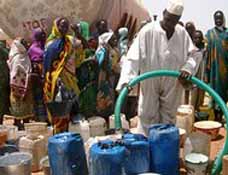 Queuing time: 7,5l/ minute = 250 people/tap, 16,6l/min = 500 people/tap, max. filling time for a container of 20l: 3 min.
Queuing time: 7,5l/ minute = 250 people/tap, 16,6l/min = 500 people/tap, max. filling time for a container of 20l: 3 min.
- As water should always be available in the household, each resident should own 2 containers of 10-20l for collection and storage, with a small neck or coverage.
- Either 250g soap/ month/ person are counted, or the use of ashes or sand is promoted.
- Communal bathing facilities with separate cubicles for men and women are installed for bathing in privacy, eventually including laundry facilities.(1basin/100people), with separate partitions for women.
Water quantity and quality
Demand per person per day:
- Drinking: 2,5 – 3l, hygiene: 2-6l
- Cooking: 3-6l
- Total: 7,5-15l
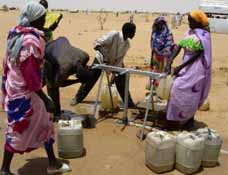 Coverage: As refugees are increasingly vulnerable to diseases, the standard demand should be supplied even if the local norm is less. Eventually, the level of local water supply could be raised to avoid animosity. Water is also needed for crops and livestock. As water related diseases are caused as much by insufficient water supply as by contamination, an insufficient amount of sufficient quality is preferred to an adequate amount of inadequate quality.
Coverage: As refugees are increasingly vulnerable to diseases, the standard demand should be supplied even if the local norm is less. Eventually, the level of local water supply could be raised to avoid animosity. Water is also needed for crops and livestock. As water related diseases are caused as much by insufficient water supply as by contamination, an insufficient amount of sufficient quality is preferred to an adequate amount of inadequate quality.
Assessment: Areas where water could become contaminated, should be controlled, such as, water sources, transportation systems and storage areas. Water quality should be tested for fecal coliform bacteria, chemical or nuclear pollution.
Disinfection: The water of the health centre should always be disinfected, if necessary by chlorine.
Protected water sources should be promoted, as natural sources like spring or river water might taste better than chlorine disinfected water.
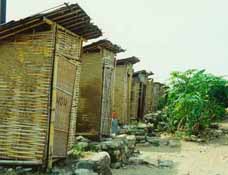 Toilets
Toilets
Availability: 1 toilet/ 20 persons, arranged by households or gender. Toilets in public spaces separated by gender/ relation of female/male: 3/1. Maximum distance to dwellings: 50m.
Initial phase: If toilets haven’t been constructed yet, a defecation field should be marked.
Siting: Safe accessibility, distance to water source at least 100 m.
…
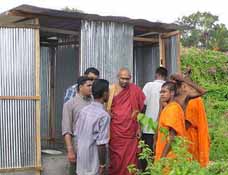 Design: The kind of toilet, with either a flush or sink pit, depends on the ground conditions, water availability and existing infrastructure. They must be usable by everyone, including children, elderly and disabled people. Extra, special toilets can be installed. Toilets should conform to cultural habits, and the required degree of privacy. The cleaning material should also be culturally appropriate: water or paper.
Design: The kind of toilet, with either a flush or sink pit, depends on the ground conditions, water availability and existing infrastructure. They must be usable by everyone, including children, elderly and disabled people. Extra, special toilets can be installed. Toilets should conform to cultural habits, and the required degree of privacy. The cleaning material should also be culturally appropriate: water or paper.
Hygiene: Toilets should be designed to be easily cleanable. Mosquito and fly breeding can be prevented by a water seal or lid. Facilities to wash hands are important. If users are involved in planning, established maintenance teams will feel more responsible for cleanliness.
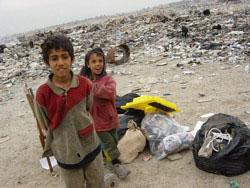
Solid waste
Household/ disposal on site: Household waste: daily burnt, buried, or put in containers for collection (100l for 10 families) (max.distance: 100m). If buried, covered with a layer of soil. Cleaning staff must wear protective clothing.
Large scale / disposal off site: Before it becomes a nuisance, a large landfill should be covered with earth.
Treatment: Goods that produce a lot of waste should not be distributed. The risk identification should be considered when deciding what to burn. According to the kind of waste, recycling should be promoted. Medical waste, infectious sharps (knives, needles) and non-sharps (wound dressings), are the most dangerous and should be disposed off separately.
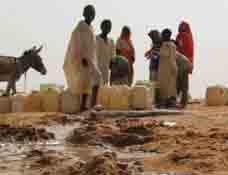
 Surface water deriving from waste-water, rain or flooding imposes health risks: Such as, contamination of water supplies and of the environment, damage to toilets and dwellings and vector breeding. Drainage can best be controlled by choice and lay-out of the site. Areas around shelters, paths and water facilities are to be kept free of standing water. Water should be drained on site rather than be irrigated trough channels that can clog. It can be controlled e.g., by small gardens for utilizing waste water. Waste water shouldn’t be mixed with toilet waste (sewage) as it is easier to be disposed off on its own. Tools for the maintenance of irrigation systems should be provided and maintenance teams should be involved in the planning.
Surface water deriving from waste-water, rain or flooding imposes health risks: Such as, contamination of water supplies and of the environment, damage to toilets and dwellings and vector breeding. Drainage can best be controlled by choice and lay-out of the site. Areas around shelters, paths and water facilities are to be kept free of standing water. Water should be drained on site rather than be irrigated trough channels that can clog. It can be controlled e.g., by small gardens for utilizing waste water. Waste water shouldn’t be mixed with toilet waste (sewage) as it is easier to be disposed off on its own. Tools for the maintenance of irrigation systems should be provided and maintenance teams should be involved in the planning.



